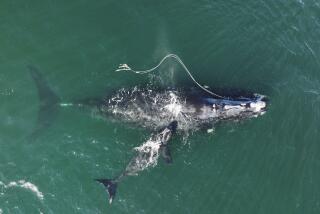Taking the Leisurely Approach to Boat Speed
- Share via
I don’t have any way, except by guessing, to know the speed my sloop is making. When under power I can tell by the sound of my 10-horsepower diesel. I check the sound against the size of my wake and pretty accurately can guess my speed.
When your top speed is not more than seven knots, as mine is, this guessing between the range of zero and seven is a fairly simple matter.
I once had one of those speed wands made of plastic tubing you stuck in the water to read the calibrations. It worked pretty well until a son-in-law stepped on it and broke it. I haven’t gotten around to replacing it.
Taking winds and currents into consideration, I can pretty well make my estimated time of arrival at, say, White’s Landing at Catalina Island come within about 15 minutes. This is good enough for me, for I’m in no hurry about anything when aboard my Herald Bird--not even arriving at the correct time. I was a naturally slow cruising man when I began taking my boat across the San Pedro Channel 14 years ago. Now, at least 150 passages later, I know I’m growing slower and slower.
I blame it on the erosion of “sea time” on my temperament. Sea time is that relaxed state of mind, when the hours seem to telescope magically into days. Morning melds into evening and you wonder how the hours passed so quickly.
I have the passage between Newport Harbor and Catalina memorized as to time and distance. But now and then, when covering unfamiliar stretches of water, it’s important to know your vessel’s speed. Perhaps you’re heading from the west end of Catalina to Santa Barbara Island. So here’s a simple formula to determine speed that requires nothing but a cigarette butt or a chip of wood.
Up near the bow make a mark on the scupper rail. Make another mark back where you steer, say at 20 feet from the bow mark. The mate drops the butt or chip in the water exactly at the mark at the bow and yells, “Time.” You start counting off the seconds, or to be more accurate use a stopwatch. When the after mark--where you’re sitting--passes the butt or chip, stop counting.
Let’s say the counted interval was four seconds. Now, .6 times distance divided by time equals knots. A distance of 20 feet divided by time or four seconds and multiplied by .6 equals three knots. That’s all there is to it. You cannot buy a cheaper patent log.
Sailing Notes
Almost all of the America’s Cup challengers have gathered in the waters off Perth, Australia, where they’re learning about local sailing conditions and shaking down their gear and crews. The trials start Oct. 5.
George Kolesnikovs of Newport Beach claims that he’s the happiest man on earth. He brought his dream boat, a 60-foot trimaran designed by John Shuttleworth and launched in 1982, across the Atlantic Ocean to Newport, R.I. There, rechristened from Travacrest to Great American, he and crew won the Buzzard’s Bay Regatta against 17 other multihulls. Great American finished first in fleet and first in handicap.
Now at the Concordia Co. yard in South Dartmouth, Mass., she is being refurbished and refitted. She will have a sail area of 2,000 square feet and a displacement of only 11,500 pounds. This winter she’ll be brought around to her home port, Newport Beach, via Panama. In November, 1987, Kolesnikovs, 44, plans to depart on a circumnavigation of the world. This will be known as the multihull Challenge 1987-88 Singlehanded Race Around the World, which he is organizing.
The race, to start off Los Angeles on Nov. 7, 1987, will be the first round-the-world race to start on the West Coast, and the first such race to permit catamarans and trimarans.
Navigational Memo: Dredging operations by Connally Pacific Co. are under way at Oceanside Harbor. The purpose is to install a sand bypass system to help prevent the harbor mouth from shoaling. Dredging is expected to continue through Nov. 30. The derrick barge American (radio call sign WYV 4377) will be at various locations throughout the outer harbor. Shoaling at Oceanside harbor mouth, resulting in rough water conditions, has become so serious that the National Weather Service has frequently announced special small-craft warnings for Oceanside exclusively.
More to Read
Sign up for The Wild
We’ll help you find the best places to hike, bike and run, as well as the perfect silent spots for meditation and yoga.
You may occasionally receive promotional content from the Los Angeles Times.




